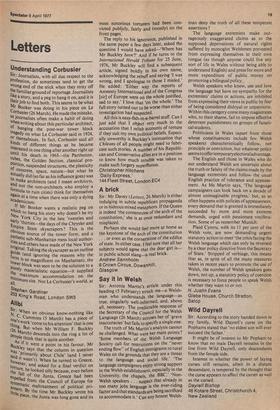Understanding Corbusier
Sir: Journalists, with all due respect to the Profession, do sometimes tend to get the wrong end of the stick when they stray off the familiar ground of reportage. Journalists like a story, and a peg to hang it on, and it is their job to find both. This seems to be what Mr Booker was doing in his piece on Le Corbusier (26 March). He made the mistake, 45 journalists often make a habit of doing when writing about this particular architect, of hanging the post-war tower block tragedy on what Le Corbusier said in 1924, or thereabouts. In fact, Corbusier said all kinds of different things as he became interested in one thing after another right up until his death in I965—the Parthenon, cubes, the Golden Section, classical proPortion, suspended structures, the plasticity of concrete, space, nature—but what he actually did (so far as his influence goes) was to make architects (and I mean architects, and not the non-architects who employ a formula to ruin cities) think for themselves again at a time when there was only a dying academicism. If Mr Booker wants a realistic peg on Which to hang his story why doesn't he try New York City in the late 'twenties and early 'thirties—the days of the Chrysler and Empire State skyscrapers ? This is the Obvious source of the tower form, and a pathetic sub-Manhattan mess local authorities and others have made of the New York °riginal. Taking the skyscraper as an outline roide (and ignoring the reasons why the ,1111 is so magnificent on Manhattan), the tower block was seen to be the solution to a the materialistic equation—it supplied Iile maximum accommodation on the
minimum site. Not Le Corbusier's world, at all
,Srephen Gardiner 403 King's Road, London SW3
































 Previous page
Previous page